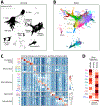The expanding landscape of inflammatory cells affecting cancer therapy
- PMID: 32203281
- PMCID: PMC7405944
- DOI: 10.1038/s41551-020-0524-y
The expanding landscape of inflammatory cells affecting cancer therapy
Erratum in
-
Publisher Correction: The expanding landscape of inflammatory cells affecting cancer therapy.Nat Biomed Eng. 2020 May;4(5):573. doi: 10.1038/s41551-020-0554-5. Nat Biomed Eng. 2020. PMID: 32249827
Abstract
Tumour-infiltrating myeloid cells (TIMCs) are critical regulators of cancer growth. The different phenotypes, functions and therapeutic effects of these phagocytes have, however, been difficult to study. With the advent of single-cell-based technologies, a new 'worldview' is emerging: the classification of TIMCs into subtypes that are conserved across patients and across species. As the landscape of TIMCs is beginning to be understood, it opens up questions about the function of each TIMC subtype and its drugability. In this Perspective, we outline the current map of TIMC populations in cancer and their known and presumed functions, and discuss their therapeutic implications and the biological research questions that they give rise to. The answers should be particularly relevant for bioengineers, materials scientists and the chemical and pharmaceutical communities developing the next generation of cancer therapies.
Figures


Similar articles
-
Harnessing immune checkpoints in myeloid lineage cells for cancer immunotherapy.Cancer Lett. 2019 Jun 28;452:51-58. doi: 10.1016/j.canlet.2019.03.018. Epub 2019 Mar 22. Cancer Lett. 2019. PMID: 30910590 Review.
-
Overcoming Therapeutic Resistance by Targeting Cancer Inflammation.Am Soc Clin Oncol Educ Book. 2016;35:e168-73. doi: 10.1200/EDBK_158948. Am Soc Clin Oncol Educ Book. 2016. PMID: 27249720 Review.
-
Pivotal role of innate myeloid cells in cerebral post-ischemic sterile inflammation.Semin Immunopathol. 2018 Nov;40(6):523-538. doi: 10.1007/s00281-018-0707-8. Epub 2018 Sep 11. Semin Immunopathol. 2018. PMID: 30206661 Review.
-
Myeloid-Derived Suppressor Cells and Proinflammatory Cytokines as Targets for Cancer Therapy.Biochemistry (Mosc). 2016 Nov;81(11):1274-1283. doi: 10.1134/S0006297916110055. Biochemistry (Mosc). 2016. PMID: 27914453 Review.
-
Sex Differences in Acute Neuroinflammation after Experimental Traumatic Brain Injury Are Mediated by Infiltrating Myeloid Cells.J Neurotrauma. 2019 Apr 1;36(7):1040-1053. doi: 10.1089/neu.2018.6019. Epub 2018 Nov 16. J Neurotrauma. 2019. PMID: 30259790 Free PMC article.
Cited by
-
New technology on the horizon: Fast analytical screening technique FNA (FAST-FNA) enables rapid, multiplex biomarker analysis in head and neck cancers.Cancer Cytopathol. 2020 Nov;128(11):782-791. doi: 10.1002/cncy.22305. Epub 2020 Aug 25. Cancer Cytopathol. 2020. PMID: 32841527 Free PMC article. Review.
-
Reshaping the tumor immune microenvironment to improve CAR-T cell-based cancer immunotherapy.Mol Cancer. 2024 Aug 26;23(1):175. doi: 10.1186/s12943-024-02079-8. Mol Cancer. 2024. PMID: 39187850 Free PMC article. Review.
-
Mechanistic studies of tumor-associated macrophage immunotherapy.Front Immunol. 2024 Sep 30;15:1476565. doi: 10.3389/fimmu.2024.1476565. eCollection 2024. Front Immunol. 2024. PMID: 39403370 Free PMC article. Review.
-
Targeting Myeloid-Derived Suppressor Cell Trafficking as a Novel Immunotherapeutic Approach in Microsatellite Stable Colorectal Cancer.Cancers (Basel). 2023 Nov 20;15(22):5484. doi: 10.3390/cancers15225484. Cancers (Basel). 2023. PMID: 38001744 Free PMC article. Review.
-
Insights into the Tumor Microenvironment-Components, Functions and Therapeutics.Int J Mol Sci. 2023 Dec 15;24(24):17536. doi: 10.3390/ijms242417536. Int J Mol Sci. 2023. PMID: 38139365 Free PMC article. Review.
References
Publication types
MeSH terms
Grants and funding
LinkOut - more resources
Full Text Sources
Medical
Research Materials

